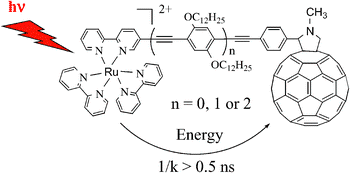Distance-independent photoinduced energy transfer over 1.1 to 2.3 nm in ruthenium trisbipyridine–fullerene assemblies†
Abstract
Ruthenium trisbipyridine C60 dyads linked viapara-phenyleneethynylene units have been prepared. They displayed a rapid energy transfer from Ru to C60 with a rate that was independent of distance, from 1.1 to 2.3 nm. The results are explained by a hopping mechanism involving a bridge-localized excited-state. In fact, for the longest bridge this state was lower in energy than the Ru-based MLCT state, as evidenced by the spectroscopic data.


 Please wait while we load your content...
Please wait while we load your content...